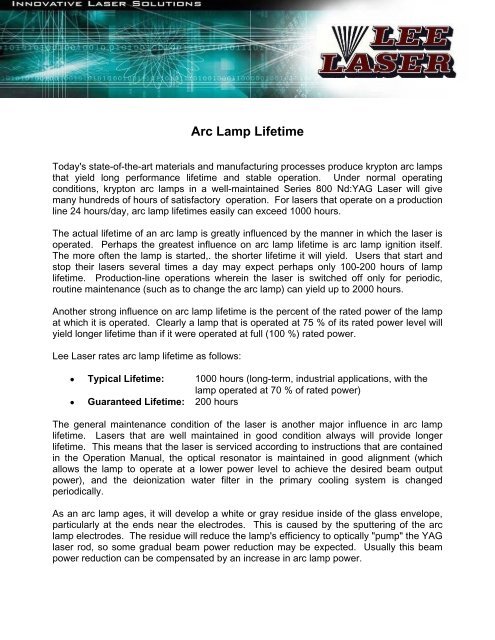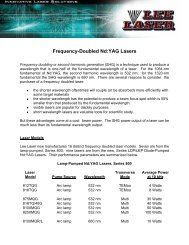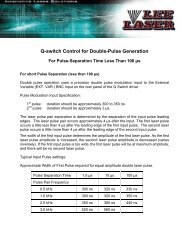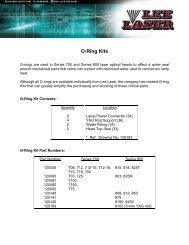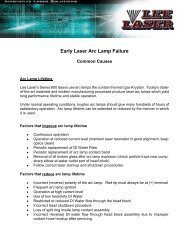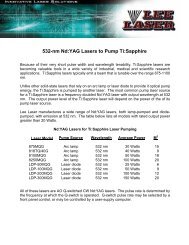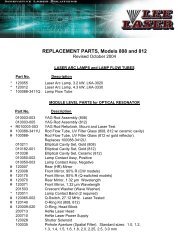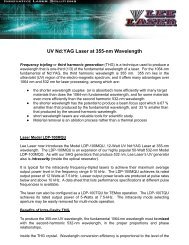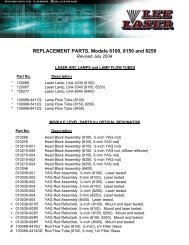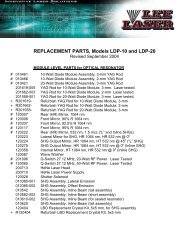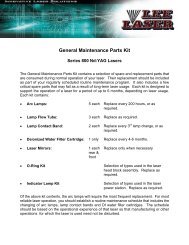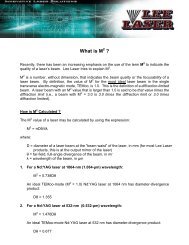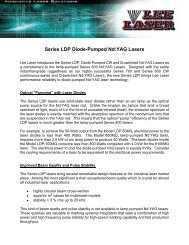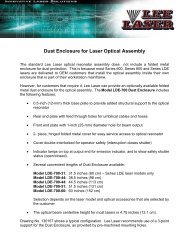Arc Lamp Lifetime - Lee Laser, Inc.
Arc Lamp Lifetime - Lee Laser, Inc.
Arc Lamp Lifetime - Lee Laser, Inc.
- No tags were found...
You also want an ePaper? Increase the reach of your titles
YUMPU automatically turns print PDFs into web optimized ePapers that Google loves.
<strong>Arc</strong> <strong>Lamp</strong> <strong>Lifetime</strong><br />
Today's state-of-the-art materials and manufacturing processes produce krypton arc lamps<br />
that yield long performance lifetime and stable operation. Under normal operating<br />
conditions, krypton arc lamps in a well-maintained Series 800 Nd:YAG <strong>Laser</strong> will give<br />
many hundreds of hours of satisfactory operation. For lasers that operate on a production<br />
line 24 hours/day, arc lamp lifetimes easily can exceed 1000 hours.<br />
The actual lifetime of an arc lamp is greatly influenced by the manner in which the laser is<br />
operated. Perhaps the greatest influence on arc lamp lifetime is arc lamp ignition itself.<br />
The more often the lamp is started,. the shorter lifetime it will yield. Users that start and<br />
stop their lasers several times a day may expect perhaps only 100-200 hours of lamp<br />
lifetime. Production-line operations wherein the laser is switched off only for periodic,<br />
routine maintenance (such as to change the arc lamp) can yield up to 2000 hours.<br />
Another strong influence on arc lamp lifetime is the percent of the rated power of the lamp<br />
at which it is operated. Clearly a lamp that is operated at 75 % of its rated power level will<br />
yield longer lifetime than if it were operated at full (100 %) rated power.<br />
<strong>Lee</strong> <strong>Laser</strong> rates arc lamp lifetime as follows:<br />
Typical <strong>Lifetime</strong>:<br />
Guaranteed <strong>Lifetime</strong>:<br />
1000 hours (long-term, industrial applications, with the<br />
lamp operated at 70 % of rated power)<br />
200 hours<br />
The general maintenance condition of the laser is another major influence in arc lamp<br />
lifetime. <strong>Laser</strong>s that are well maintained in good condition always will provide longer<br />
lifetime. This means that the laser is serviced according to instructions that are contained<br />
in the Operation Manual, the optical resonator is maintained in good alignment (which<br />
allows the lamp to operate at a lower power level to achieve the desired beam output<br />
power), and the deionization water filter in the primary cooling system is changed<br />
periodically.<br />
As an arc lamp ages, it will develop a white or gray residue inside of the glass envelope,<br />
particularly at the ends near the electrodes. This is caused by the sputtering of the arc<br />
lamp electrodes. The residue will reduce the lamp's efficiency to optically "pump" the YAG<br />
laser rod, so some gradual beam power reduction may be expected. Usually this beam<br />
power reduction can be compensated by an increase in arc lamp power.
2<br />
Another indicator of arc lamp age is a noticeable increase in beam power instability. As<br />
the lamp ages, the sputtering of the electrodes causes uneven erosion at the tips of the<br />
electrodes. This uneven wear will cause the plasma arc to spatially wander about the tips<br />
of the electrodes, and result in an uneven optical pumping of the YAG rod. The uneven<br />
pumping causes beam power instability. Often, this also will produce unstable arc lamp<br />
power as viewed on the kilowatt meter on the front panel of the power supply.<br />
The most common causes of poor arc lamp lifetime are:<br />
1. frequent starting of the arc lamp<br />
2. poor alignment of the laser optical resonator<br />
For more information, refer to the following <strong>Lee</strong> <strong>Laser</strong> technical bulletins:<br />
Early <strong>Laser</strong> <strong>Arc</strong> <strong>Lamp</strong> Failure, Common Causes<br />
Alignment of the <strong>Laser</strong> Optical Resonator<br />
<strong>Laser</strong> Maintenance and Servicing<br />
<strong>Arc</strong> lamp lifetime can be improved by operating the lamp at a reduced power level.<br />
From reports by many users we know that those which perform routine service and<br />
maintain their lasers in good operating condition always achieve the best arc lamp lifetime.<br />
Good operating condition includes periodic check of optical resonator alignment with a<br />
laser power (Watt) meter and other test instruments.<br />
Also, the gold elliptical reflector should be checked for its condition, and the DI<br />
(deionization) water filter should be changed periodically to maintain the proper electrolytic<br />
level and oxygen removal (see <strong>Lee</strong> <strong>Laser</strong> bulletin, Deionized Water Quality).<br />
Clearly, if the optical resonator is properly aligned and the gold pump chamber is in good<br />
condition, the laser will operate most efficiently. Less arc lamp power will be needed to<br />
produce the beam power necessary for your work.<br />
Disposal of Used or Defective <strong>Laser</strong> <strong>Arc</strong> <strong>Lamp</strong>s<br />
<strong>Laser</strong> arc lamps are manufactured totally from inert materials: glass, stainless steel,<br />
tungsten and krypton gas. As such, used or defective laser arc lamps, including broken<br />
arc lamps, may be discarded without fear of any harm to the environment.<br />
Users should consult your local or business environmental office or agency for the correct<br />
disposal procedure in your area.
3<br />
Differences in <strong>Arc</strong> <strong>Lamp</strong> Appearance<br />
<strong>Lee</strong> <strong>Laser</strong> purchases laser arc lamps from several different manufacturers. Each<br />
manufacturer may use slightly different design details for the internal electrode, so the<br />
lamps from one manufacturer may differ slightly in appearance from those of another<br />
manufacturer.<br />
However, all of the lamps that are specified by <strong>Lee</strong> <strong>Laser</strong> for use in a particular laser<br />
model will have the same dimensions (length and envelope diameter), the same gas fill<br />
pressure and the same operating voltage (within manufacturing tolerances). As such, all<br />
of the lamps bear the same performance warranty by <strong>Lee</strong> <strong>Laser</strong>, regardless of<br />
manufacturer. <strong>Arc</strong> lamp manufacturers provide no warranty whatsoever.


